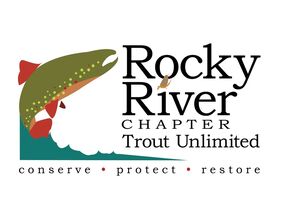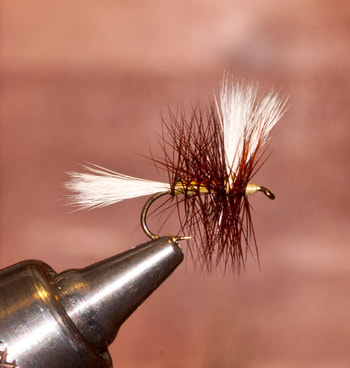Fly of the Month 02.2014
Corey's Calf Tail
Some Southern Appalachian fly patterns are modified versions of fly patterns that were found to be successful in other parts of the country and sometimes other parts of the world. We present a fly pattern that originated as a fly pattern designed for night fly fishing in Michigan. As with other fly patterns from the northeast and mid-west, Corey’s Calf Tail was systematically modified for use in the rougher waters of Southern Appalachians streams soon after its original creation and use.
Corey’s Calf Tail
Corey’s Calf Tail was created around the mid-1940’s by the late Ralph Corey of Big Rapids, Michigan. The fly pattern became well known in western Michigan over the next 30 years. L.L. Robey of Newaygo Michigan tied and marketed the fly pattern commercially beginning in the 1970’s. The original Corey’s Calf Tail is still considered an important attractor fly pattern on the Au Sauble, Pere Marquette and Manistee Rivers. From the late-1940’s, the fly pattern was adopted and modified by Southern Appalachian anglers soon after its creation to become a highly visible, high-floating attractor fly.
The original night fly pattern version was tied with a white calf tail, a single white calf tail topper wing (single bunch of hair angled forward over the eye of the hook, yellow floss or dubbed body with gold wire ribbing and brown hackle. Today, this original version can be purchased or custom ordered with a black, green, red, yellow or other color body from tied by Aaron Marzec.
As the fly pattern already sounds like a recipe for success, the Southern Appalachian version has several key modifications that improve on the original. The white calf tail wing is tied upright and divided to be able to see the fly better as well as making the fly float better. A brown (and for some versions a grizzly) hackle is palmered through the entire body to make the fly float better as well. Calf body hair rather than calf tail is used on some versions giving the fly pattern a much straighter looking tail. This modification over 50 years ago simply required less calf tail material for each fly, a precious and more expensive material compared to calf body hair.
Needless to say, these modifications created a very different Corey’s Calf Tail for local use. Our Southern Appalachian version of Corey’s Calf Tail may be ordered as a custom tie from “TIE ONE ON”, Flies by Susan Cox, 199 Tamassee Knob Road, Tamassee, SC 29686 – Phone (864) 944-0852.
Roger Lowe’s Fly Pattern Guide to the Great Smoky Mountains includes Corey’s Calf Tail fly pattern recipe as well. You can also find Corey’s Calf Tail in various mountain stores where local mountain fly tyer are earning some extra money by tying and selling their flies. I have purchased a few in the past at the Citico service station on US 19E in Almond, NC.
Fly Fishing with Corey’s Calf Tail
If you encounter high, dingy water, rough water or even water with glaring reflections and dark zones that make it very challenging to see a fly, Corey’s Calf Tail is an excellent fly to turn to for proven results. Whether a trout strikes it or not, there is no doubt that the fly will be highly visible and easy to follow on the drift.
The dense, white divided-wings and white tail provide a highly visible fly as well as a high floating fly. The palmered, hair-wing fly pattern is virtually unsinkable even in fishable rapids and cascades. If you have experienced the use of a Royal Wulff with the highly visible white calf tail divided wings, then imagine a fly with the same or better visibility with an added dense, white tail that floats higher due to the palmered hackle body.
Fish Corey’s Calf Tail in the same manner as a Wulff, Irresistible or any high floating attractor. Trout strike this fly through fast currents very aggressively with no turning back.
Corey’s Calf Tail is an excellent fly pattern for dusk, dawn and dark overcast conditions when visibility on the stream is minimal. Night fly fishing in North Carolina is only allowed on the lower Nantahala River (a regulation exception since rafters overwhelm these waters during the day) and Corey’s Calf Tail is a top of the list choice for such unique night fly fishing.
Corey’s Calf Tail
Hook : Dry Fly 1x, 1 L, TDE, Tiemco 100 or equivalent, 10,12,14,16,18
Thread : Uni 8/0 Light Cahill or equivalent
Tail : White Kip or Calf Tail
Abdomen : Lt Cahill thread
Thorax : Lt Cahill thread
Hackle : Brown Rooster, dry
Directions :
- Wrap thread one third back from eye, starting one to two eye lengths from eye, let bobbin hang
- Select calf tail hair and cut. Clean underfur thoroughly and stack in hair stacker. Tap several times and remove with right hand, pinching the tips between the index finger and thumb, maintain alignment. Place calf tail on top of the hook, with the length to be tied in, about the same length as the hook shank. Wrap softly at the one third back mark and release the grip with the right hand. The wraps should be very close together working toward the hook bend. This is only to position and judge the height of the wings. Once you are happy with the wings, tie in firmly and trim the hair making a diagonal cut. Now the calf tail can be secured by binding the diagonal with firm wraps. Advance the thread immediately forward of the hair and lifting the bundle of hair on the top of the shank with your left hand, pull the thread against the base of the tie in, on top of the shank and pull the thread away and toward the hook bend. When you pull the thread in a straight and parallel (to the hook shank) fashion the hair will stand straight up. Make several turns immediately in front of the hair. Take the thread and divide the upright hair clump into two fairly even sections. Use a figure eight wrap to divide and shape the wings. Once secure take the thread to behind the diagonal cut of the hair (the hair on top of the hook should be pretty well covered by thread now) and let the bobbin hang
- Repeat the selection of calf tail, choosing a smaller portion of hair to make the tail. Tie in on top of the hook shank with the length being about the same as the hook shank. By butting the tail up to the trimmed wing material, you will form a more even body. Once the tail is secure let the bobbin hang above the hook barb.
- Select a Brown Rooster feather with barbs about one and one half the hook gape and pull away about a quarter inch of barbs. Tie in, shiny side to the front. The idea is to be able to make one full wrap (with no barbs), after tying in, so that the barbs do not bind up on themselves at the beginning of the wraps. As you advance the crossover and bunching are okay, but this technique avoids barbs not being neat at the back of the hackle making for a neater profile. Secure the hackle with thread at the tail and advance the thread in even and touching wraps to form a thread body. Advance the thread to the head in front of the wings and let the bobbin hang.
- Wrap the hackle forward in open wraps with some space between each turn until reaching the wings. The thorax should be denser with hackle, so begin touching turns of hackle for the thorax. This is the “usual” wrap of hackle on a dry. Continue to in front of the wing, trap and tie off, trimming any excess.
- Form a thread head, whip finish and add head cement if desired.

